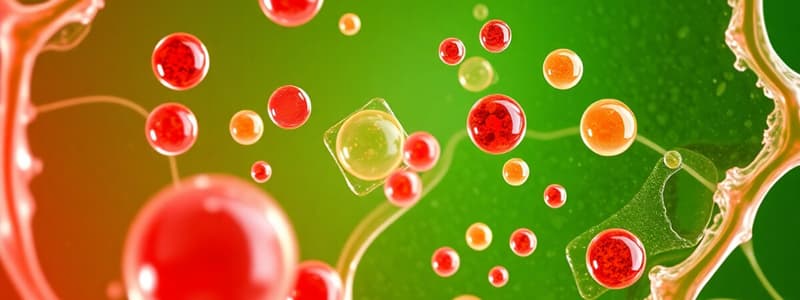Podcast
Questions and Answers
What is the primary function of chloroplasts?
What is the primary function of chloroplasts?
- Storing water and nutrients
- Producing energy using sunlight (correct)
- Breaking down waste materials
- Controlling cell division
Which of the following structures is typically NOT found in animal cells?
Which of the following structures is typically NOT found in animal cells?
- Cell membrane
- Mitochondria
- Cell wall (correct)
- Vacuole
What does the cell theory state about the origin of cells?
What does the cell theory state about the origin of cells?
- Cells are created from unknown sources
- All cells arise spontaneously
- All cells come from pre-existing cells (correct)
- Cells are formed from non-living matter
Which term describes an organism composed of a single cell?
Which term describes an organism composed of a single cell?
What is the gel-like substance inside a cell called?
What is the gel-like substance inside a cell called?
What does DNA, found within cells, provide?
What does DNA, found within cells, provide?
In plant cells, what is the function of the large central vacuole?
In plant cells, what is the function of the large central vacuole?
What is the function of mitochondria within a cell?
What is the function of mitochondria within a cell?
Flashcards
What is cell theory?
What is cell theory?
The theory that all living organisms are made of cells.
What is an organelle?
What is an organelle?
A membrane-bound structure within a cell that carries out a specific function. Examples include the nucleus, mitochondria, and chloroplasts.
What are mitochondria?
What are mitochondria?
Organelles that produce energy for the cell through cellular respiration.
What is a cell wall?
What is a cell wall?
Signup and view all the flashcards
What is a large central vacuole?
What is a large central vacuole?
Signup and view all the flashcards
What is cytoplasm?
What is cytoplasm?
Signup and view all the flashcards
What is the nucleus?
What is the nucleus?
Signup and view all the flashcards
What is a chloroplast?
What is a chloroplast?
Signup and view all the flashcards
Study Notes
Cell Structure and Function
- Cells are the basic units of life. All living organisms are made of one or more cells.
- Cells are the basic units of structural and organizational biology in all living organisms.
- All cells come from pre-existing cells.
Animal Cells vs. Plant Cells
- Animal cells are typically smaller and more irregular in shape compared to plant cells.
- Plant cells tend to have a boxy or rectangular shape, and they have a cell wall.
- Animal cells do not have a cell wall.
- Animal cells may have multiple, small vacuoles, while plant cells have one large central vacuole.
- Plant cells contain chloroplasts, which are crucial for photosynthesis. Animal cells do not have chloroplasts.
- Both plant and animal cells have mitochondria and other membrane-bound organelles.
Organelles
- Organelles are specialized structures within cells that perform specific functions.
- Examples of organelles include the nucleus, mitochondria, chloroplasts, vacuoles, endoplasmic reticulum, and ribosomes.
- The nucleus contains the cell's DNA, which controls cell activities.
- Mitochondria are responsible for cellular respiration, producing energy for the cell.
- Chloroplasts are found in plant cells and are vital for photosynthesis.
- Vacuoles store water, nutrients, and waste products.
- The endoplasmic reticulum and ribosomes play roles in protein synthesis and transport.
Types of Cells
- Unicellular organisms consist of a single cell, while multicellular organisms have multiple specialized cells organized into tissues, organs, and organ systems.
- Unicellular organisms, like Amoeba and Paramecium, are single-celled organisms that perform all life functions within a single cell
- Multicellular Organisms have different cells with specialized roles, tissues, organs, and systems. For example, animals have a digestive system, respiratory system, and more.
Studying That Suits You
Use AI to generate personalized quizzes and flashcards to suit your learning preferences.




